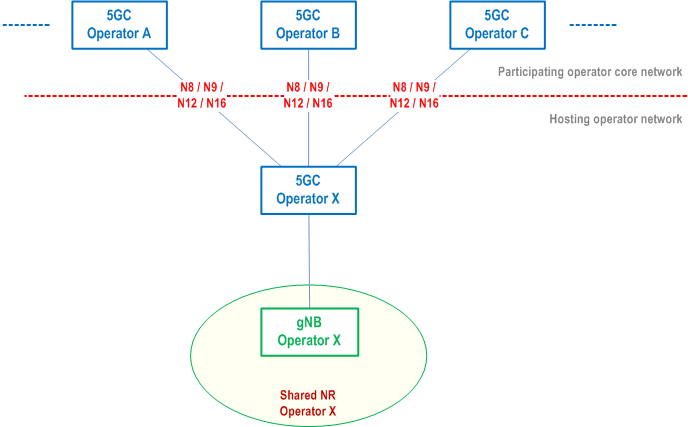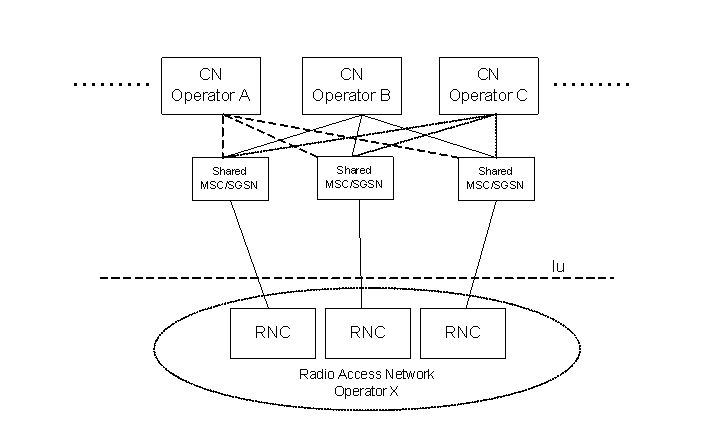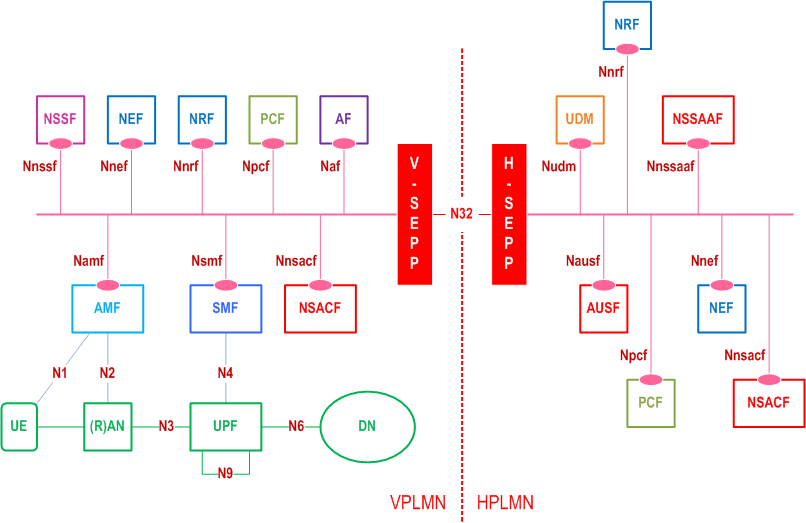Network Sharing - A Shallow Dive!
Network Sharing as a feature has been available in 3GPP standards for quite sometime. 3GPP Spec 23.251 introduced this concept and it has been augmented by 2G/3G/4G/5G evolutions as well.
In this post, I would like to explore the nuances of network sharing for a 5G network including topics like MOCN, Indirect Network Sharing etc. Also I would record my observations with regards to its relevance towards traditional roaming architectures and private networks as well.
Network Sharing Definition
3GPP Spec TS 23.251 [6] defines the concept of Network Sharing as follows
A network sharing architecture shall allow different core network operators to connect to a shared radio access network. The operators do not only share the radio network elements, but may also share the radio resources themselves.
Specifically, TS 23.501 [5] section 5.18 redefines the network sharing concept for 5G networks as follows
The shared network operator allocates shared resources to the participating operators based on their planned and current needs and according to service level agreements.
So in a nutshell, for the purpose of pooling network resources for various commercial, administrative & geographical reasons, some network operators may choose to share their network infrastructures at varying degrees with each other. 3GPP has tried to standardize these sharing architecture in great detail.
Network Sharing Taxonomy
First let us clarify few terminologies
Network Operator (NOP) The entity responsible for operating a telecom network. For the most part, this could telco service provider who invests in telecom infrastructure & provide service to end users. Sometimes, a service provider may choose to lease their infrastructure or provide access to the resources for another NOP to operate on their network.
Hosting Network & Operator This is the network that has the shared RAN portion. Hence a hosting network will have its own Core and RAN Network, just that the RAN portion of the hosting network is being shared with other operators
Participating Network & Operator This is the network or the NOP who have a network sharing agreement with the “Hosting” Network Operator.
Types of Network Sharing
Now that we understood some basic terminologies, let’s explore the types of network sharing documented in 3GPP specs. There appears to be 3 Types of Network Sharing architectures, that are documented.
1) Multi Operator Core Network (MOCN)
In this architecture, multiple NOP(s) sharing the same radio network (RAN) but each have their own dedicated core networks (5GC). Contrary to the name, NOPs doesn’t operate on a single Core. Instead each NOP’s core operate on a shared RAN.
In other words, Participating Network’s Core will be connected to the Hosting Network’s RAN directly using N2/N3/N6 interfaces.

2) In-Direct Network Sharing
Some text [1] suggest that this indirect network sharing is part of MOCN architecture but it is not entirely clear whether this is a subset of MOCN or is simply another architecture that is documented along with MOCN.
In the indirect network sharing, the hosting network’s Core & RAN will be the anchor point for other participating networks. But the hosting network’s core function is NOT shared with other participating operators. Instead, the control signals are routed through the hosting network’s core network.
This is very analogous to the roaming architecture but with a subtle difference. Incase of roaming, users are typically not aware of the visited network. Whereas in case of indirect sharing, the UE will select the PLMN ID explicitly to attach to the desired network. More details follows.

3) Gateway Common Core Network (GWCN)
In this architecture, NOPs can choose to share both RAN and Core network functions as per their sharing agreement. There appears to be no rigid standardization around this architecture 1.

Based on my research, it appears that the network sharing concept was around 2G time and later the concept was extended to LTE and 5G as well. However for 5G only the MOCN & Indirect sharing architecture was standardized and there is no evidence for the 5G flavor of GWCN architecture.
Shallow dive on MOCN
Given the premise that network sharing involves more than one network, Within MOCN, let us understand how the network selection typically work.
In general, each operator (irrespective of hosting vs participating) will have their own network ids to stamp their network. This is achieved by another term called PLMN ID 2. PLMN is further broken down MCC & MNC 3 whose combination will identify an operator’s network uniquely.
When a UE 4 powers on, it scans for the available networks over the air and the gNB5 serves this information in the form of PLMN IDs.6
Network Selection in MOCN
In a MOCN architecture based network, the shared gNB will instead serve all the PLMN IDs in the System Information Block (SIB) from the available participating NOPs as well as seen in Figure 4. Based on several criteria like Location, Cell Boundary, Application Specific triggers etc, a UE will select a specific PLMN ID from the available list and request the “network attach” to gNB. The shared gNB will then use this selected PLMN ID to route the UE request to relevant core network. This could be the home 5GC or any one of the participating 5GC. Based on that target core’s control & policy, the UE will either be accepted or [email protected].

Network Selection in Indirect
Incase of indirect sharing architecture, the hosting network’s AMF will select the relevant participating network’s AMF to route the UE attach request if needed. Communication between the peer 5GC nodes happens via SEPP (Secure Edge Protection Proxy) network function involving the N32 interface of 5GS. Hence this mimics the traditional 5G roaming architecture as depicted in Figure 5
Once the hosting AMF determines the target AMF from the participating network, it would assign itself as a visitor peer. In other words, the host network would become the visiting network and the selected participating network would become the home network for this UE. From this point, it follows the 5G roaming architecture as usual, except for charging I guess.

Support for Private Networks in MOCN/Indirect Sharing
Before we delve into this, let us first go through even more jargons about private network.
3GPP has done some heavy standardization around private networks as seen in [2]. In fact they have also given a special name called Non-Public Networks for private networks. As usual this also comes with some more definitions which we need to understand to interpret the specs.
The NPNs is further classified into 2 major category
Standalone Non Public Networks (S-NPN) This network is purely private and doesn’t share any of its infrastructure with public networks. This kinda networks are purely used by large & small enterprises by means of procuring private spectrum like CBRS 7 or by leasing spectrum from other spectrum providers
Public Network Integrated Non Public Networks (PNI-NPN) This network is being offered by the public network providers as a subnetwork or as a slice from their existing public network. One of the main characteristics of this network is the concept of Public to Private roaming.
Because there are 2 categories of the network, there can be multiple combinations of private & public network ids in the play when the shared gNB is broadcasting the network ids to the UE. TS 23.501 details all the possible combinations and the spec goes into greater detail. But for the most part, the spec uses the shall language, signifying that there is no visible difference in supporting private or public networks when it comes to network sharing.
Furthermore the spec also states that the individual Cells can be directly tied to one or more SNPNS, one or more PNI-NPS (with CAG) or one or more PLMNs, which effectively means the network sharing concept is applied to both public, private networks alike.
The spec also contains 2 very important notes, which I would like to record as well.
- Network sharing with PNI-NPN is allowed only with CAG (Closed Access Group). This means, a public network cannot simply allow all of its users to share a site that happens to be a private network.
- In network sharing, because there are more than 1 AMF involved, it might be theoretically possible that the 5G TMSI 8 collision might occur. The spec assumes this is a lower risk and the participating operators should mitigate it as per their implementation.
Neutral Host Networks - Putting MOCN to use
One of the popular usage of MOCN architecture nowadays is another concept called Neutral Host. Neutral hosts are the host network that can connect to any other MNOs (Mobile Network Operators) thereby extending the coverage of that MNO.
Because a NHN can in reality be any MNO, hence the name neutral host. NHNs are implemented as MOCN under the hood. When a MOCN hosting operator share its RAN subnet with multiple MNOs either via traditional MOCN or via Indirect MOCN, it becomes a NHN host. The most common implementation of NHN is done via something called MOCN Gateway [3].
This MOCN Gateway can either a direct MNO integration via N2/N3 interconnect or via specific IpSec Tunnels [4] or it could be using a SEPP like approach [3] as well.
In contrast to other alternatives like DAS9, MOCN Gateway based solutions are touted to be cost effective & flexible for MNOs to extend their coverage [4] [3] to spotty, crowded & less ROI areas where they cannot invest additional radio resources. By using NHNs, MNO subscribers can enjoy the same services like emergency services, emergency alerts, wireless priority services [4] etc.
Key Takeaways:
- Neutral Host Networks extend the public networks to private locations using MOCN approach
- NHNs are implemented using a technique called MOCN Gateways
- MOCN Gateways are nothing but either indirect MOCN architecture using SEPP or traditional MOC using IPSec tunnels.
Well, if you are at this point, then please accept my sincere thanks for your patience and really appreciate for giving me your time. I hope it was worth it. I intend to blog more on the intersection of telecom, wireless research, artificial intelligence and if that is something that resonates with you, please do follow my blog.
I also publish a newsletter where I share my techo adventures in the intersection of Telecom, AI/ML, SW Engineering and Distributed systems. If you like getting my post delivered directly to your inbox whenever I publish, then consider subscribing to my substack.
I pinky promise 🤙🏻 . I won’t sell your emails!
References
Footnotes
Perhaps it existed in a notional level as it requires too much control & coordination among participating operators↩︎
Public Land Mobile Network Identifier↩︎
Mobile Country Code & Mobile Network Code↩︎
User Equipment. It is also termed as Mobile Station in some specifications but it generally refers to any device that is connecting to the network using some form of identification. It could be your normal mobile phones, IOT sensors, your TVs, microwave etc.↩︎
Abbreviates to gNodeB↩︎
For the most part this process is automatic & controlled by the service provider, especially if you buy your phone from a carrier, the device is locked to a particular carrier. Hence the phone will always latch to a specific provider’s network, but in unlocked phones, you can override to manual selection as well.↩︎
Temporary Mobile Subscriber Identity - this is a security feature where instead of using UE’s IMSI, a temporary identifier is used for the UE authentication so that IMSI cannot be spoofed or eavesdropped.↩︎
Distributed Antenna System↩︎